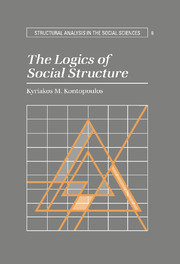Part IV - Heteracrchical logics
Published online by Cambridge University Press: 24 October 2009
Summary
The following two chapters focus on the Logic of Heterarchy, the basis of my own research program. Admittedly, this is the most complex type and is located – somewhat peculiarly – in the gray area between the constructionist and hierarchical logics. Here I build on Hofstadter's (1979) provocative initial analyses of “tangled systems” providing an elaborated transcription of the heterarchical talk into sociological talk. The emphasis is on the analytical characteristics of the heterarchical model of social structure, as described in the theses discussed in Chapter 4; the phenomenological description of social structures along the lines of this model follows in Part V.
Chapter 10 presents and appraises various theories of structuration, which have made an effort to go beyond the simpler constructionist models by introducing a certain dialectic between agency and structure; I also offer here my own positive heuristic on how a successful heterarchical research program can be fully developed.
In Chapter 11, which incorporates a considerable degree of speculation, I discuss the exciting developments in the area of neural networks as a possible, advanced model of social structure; this may seem to be an interruption of the sociological argument proper, but there is an important insight to be gained as we survey the parallel distributed connections between the neuronal/mental and the individual/social levels. By combining the discussion in Chapters 3 and 4 with that of Chapters 10 and 11, we can better understand the interlevel linkages between the numerous social structures to be described in Part V.
- Type
- Chapter
- Information
- The Logics of Social Structure , pp. 209 - 210Publisher: Cambridge University PressPrint publication year: 1993



